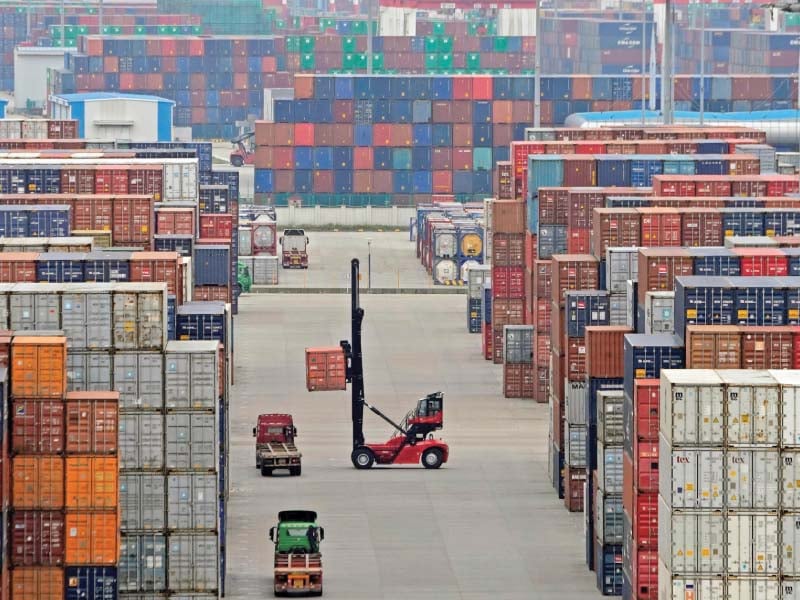
ISLAMABAD: Pakistan’s exports flattened at $17 billion in first nine months of this fiscal year despite 34% currency devaluation in the last over one year, underscoring the need to review a strategy to weaken the currency for gaining export competitiveness.
Where the growth in exports flattened in nine months, it, in fact, dipped over 11% on a year-on-year basis in March.
Despite almost no growth in exports, the trade deficit further contracted to $23.7 billion from July through March on back of steep reduction in imports, reported Pakistan Bureau of Statistics on Wednesday.
Trade deficit that stood at $27.2 billion in July-March period of last fiscal year shrank 13% to $23.7 billion in the corresponding period of the fiscal year 2018-19, the PBS report showed. In absolute terms, there was a reduction of $3.6 billion in the trade deficit and entire reduction came from the import side.
Overall imports during July-March period of this fiscal year dropped 8% to $40.8 billion, indicating that this year imports would not hit the record level achieved in the previous fiscal year. But the improvement was large because of a reduction in machinery imports.
Exports during the first nine months of the current fiscal year amounted to only $17 billion, higher by just 0.1% or $19 million. But the cost that the country paid to get $19 million benefit runs into billions of dollars in addition to the pain that the consumers are passing through due to increase in the cost of almost every utility due to currency depreciation.
This came despite the fact that the central bank, in consultation with the finance ministry, let the currency depreciate by 35% since January last year. The Pakistan Muslim League-Nawaz (PML-N) government had given an Rs180-billion package to the exporters. The Pakistan Tehreek-e-Insaf (PTI) government has also provided over Rs30-billion package in shape of lower gas and electricity prices.
Finance Minister Asad Umar has already announced to link the value of the rupee with the Real Effective Exchange Rate, which will require further adjustments in the months ahead.
There had been strong criticism against former finance minister Ishaq Dar for keeping the exchange rate fixed at Rs105 to a dollar till October 2017 that according to the economists damaged the exports potential. After that both, the former finance minister Miftah Ismail and incumbent Finance Minister Asad Umar advocated devaluing the currency for gaining export competitiveness.
But Umar was of the view that the damage caused by an overvalued rupee was not only limited to exports. It also led to de-industrialization due to the influx of cheaper imports, according to Umar.
The weak rupee helped contain the imports but it also adversely hit the tax collection of Federal Board of Revenue (FBR). The arguments of the International Monetary Fund (IMF) and the finance ministry that currency depreciation would also improve revenue collection by at least Rs100 billion at the import stage have proven wrong.
The quantum of exports in the first nine months was equal to only 63% of the $27 billion annual targets that the PTI government has set for itself.
Pakistan closed the last fiscal year at $37.6 billion of trade deficit, which became the key reason behind the highest-ever current account deficit of $18.9 billion in the year. The PTI government wants to cut the trade deficit close to $26 billion, which seems highly impossible now. The value of exported goods was 240% less than the value of imports, which continuously improved because of the reduction in the import bill.
Despite the contraction in exports, the IMF has predicted a current account deficit of 5.2% of GDP for this fiscal year.
The trade balance in March 2019, as compared to the same month a year ago, improved but only because of the contraction in imports. The trade deficit shrank 28% from $3 billion to $2.2 billion in March this year. In absolute terms, there was a reduction of $849 million in the trade deficit on an annual basis.
In March 2019, the imports in dollar terms declined to $4.2 billion compared to $5.3 billion in the same month last year, which reflected a contraction of over 21%, reported the PBS. But exports also decreased by 11.1% to $1.98 billion in March, a net reduction of $248 million.
On a month-on-month basis, the exports surged 4.8% in March over the preceding month. Exports increased by only $90 million to $1.98 billion. Imports marginally contracted by 0.6% to $4.2 billion last month. Resultantly, the trade deficit contracted 5% to $2.2 billion in March over February.
Published in The Express Tribune, April 11th, 2019.
Like Business on Facebook, follow @TribuneBiz on Twitter to stay informed and join in the conversation.



































































COMMENTS
Comments are moderated and generally will be posted if they are on-topic and not abusive.
For more information, please see our Comments FAQ